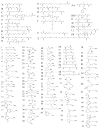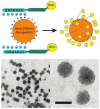A combinatorial polymer library approach yields insight into nonviral gene delivery
- PMID: 18507402
- PMCID: PMC3490629
- DOI: 10.1021/ar7002336
A combinatorial polymer library approach yields insight into nonviral gene delivery
Abstract
The potential of gene therapy to benefit human health is tremendous because almost all human diseases have a genetic component, from untreatable monogenic disorders to cancer and heart disease. Unfortunately, a method for gene therapy that is both effective and safe has remained elusive. It has been said that "there are only three problems in gene therapy - delivery, delivery, and delivery." (quote from I. M. Verma in Jaroff, L. TIME, 1999; Jan 11). This Account describes an alternative strategy to viral gene delivery: the design of biodegradable polymers that are able to deliver DNA like a synthetic virus. Using high-throughput synthesis and screening techniques, we have created libraries of over 2000 structurally unique poly(β-amino esters) (PBAEs). PBAEs are formed by the conjugate addition of amines to diacrylates. These biomaterials are promising for nonviral gene delivery due to their ability to condense plasmid DNA into small and stable nanoparticles and their ability to promote cellular uptake and endosomal escape. Our laboratory has iteratively improved PBAE nanoparticles through polymer end modifications and nanoparticle coatings. Lead PBAEs have high gene delivery efficacy and low cytotoxicity both in vitro and in vivo. Certain polymer structural characteristics are important for effective gene delivery. The best PBAEs are linear polymers of ~10 kDa that contain hydroxyl side chains and primary amine end groups. These polymers bind DNA to form nanoparticles that are small (<200 nm) and stable and have near-neutral ζ potential in the presence of serum-containing media. Lead PBAEs also contain tertiary amines that can buffer the low pH environment of endosomes and facilitate escape of polymer/DNA particles into the cytoplasm. Diamine end-modified 1,4-butanediol diacrylate-co-5-amino-1-pentanol polymers (C32) bind DNA more tightly and form smaller nanoparticles than other PBAEs. These nanoparticles also have higher cellular uptake and the best gene expression of all gene delivery polymers in the library. These polymers are more effective for gene delivery than top commercially available nonviral vectors including jet-PEI and Lipofectamine 2000 and are comparable to adenovirus for in vitro gene delivery to human primary cells. In vivo, these PBAE/DNA particles are promising as cancer therapeutics. This Account summarizes the results of our laboratory in using a combinatorial polymer library approach to elucidate polymer structure/function relationships and enable the development of polymeric gene delivery nanoparticles with viral-like efficacy.
Figures










References
-
- Gene Therapy Clinical Trials Worldwide provided by the Journal of Gene Medicine. 2007 www.wiley.co.uk/genmed/clinical/ - PubMed
-
- Hollon T. Researchers and regulators reflect on first gene therapy death. Nat Med. 2000;6:6. - PubMed
-
- Check E. Gene therapy put on hold as third child develops cancer. Nature. 2005;433:561. - PubMed
-
- Wagner E, Kircheis R, Walker GF. Targeted nucleic acid delivery into tumors: new avenues for cancer therapy. Biomed Pharmacother. 2004;58:152–161. - PubMed
-
- Putnam D. Polymers for gene delivery across length scales. Nat Mater. 2006;5:439–451. - PubMed
Publication types
MeSH terms
Substances
Grants and funding
LinkOut - more resources
Full Text Sources
Other Literature Sources

